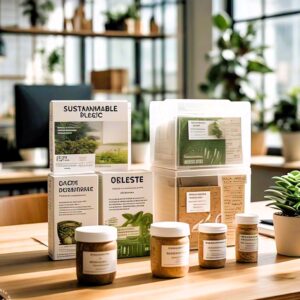Plastic Pollution: Solution to the Plastic Problem in 2025
Plastic pollution is a big problem. It harms our environment and health. People use plastic every day. They throw it away after use. This waste goes into the oceans and land. It kills animals and plants.
plastic pollution, accumulation in the environment of synthetic plastic products to the point that they create problems for wildlife and their habitats as well as for human populations. In 1907 the invention of Bakelite brought about a revolution in materials by introducing truly synthetic plastic resins into world commerce. By the end of the 20th century, plastics had been found to be persistent polluters of many environmental niches, from Mount Everest to the bottom of the sea. Whether being mistaken for food by animals, flooding low-lying areas by clogging drainage systems, or simply causing significant aesthetic blight, plastics have attracted increasing attention as a large-scale pollutant.

What is Plastic Pollution?
Plastic pollution is the accumulation of plastic waste in the environment. It comes from plastic bags, bottles, and other items. These items are not biodegradable. They stay in the environment for a long time.
Why is Plastic Pollution a Problem?

Plastic pollution is a problem because it harms animals and plants. Animals eat plastic and get sick. Plants get covered in plastic and die. Plastic pollution also affects human health. It contaminates water and air.
How Did Plastic Pollution Become a Problem?
Plastic pollution has become a problem because of human actions. People use too much plastic. They do not dispose of it properly. Governments and companies did not regulate plastic use. Now, plastic waste is everywhere.
Consequences of Plastic Pollution
The consequences of plastic pollution are severe. It kills millions of animals every year. It also affects human health. People who live near plastic pollution sites have more health problems.

Solutions to Plastic Pollution
There are solutions to plastic pollution. People can reduce plastic use. They can reuse plastic items. Governments and companies can regulate plastic use. They can also clean up plastic waste.
Plastic pollution is a big problem. It harms our environment and health. We must take action to reduce plastic use and clean up plastic waste. We can make a difference by changing our habits and supporting companies that reduce plastic use.
future generations.
Solutions to Plastic Pollution
Plastic pollution is a major problem. We need to solve it. Here are some solutions:
Reduce Plastic Use
We can reduce plastic use by:
Using reusable bags
Avoiding single-use plastics
Choosing products with minimal packaging
Recycle Plastic
We can recycle plastic by:
Sorting plastic waste
Using recycling bins
Supporting recycling programs
Proper Waste Disposal
We can dispose of waste properly by:
Throwing away trash in bins
Avoiding littering
Supporting waste management systems
Use Biodegradable Alternatives
We can use biodegradable alternatives by:
Using paper or cloth bags
Choosing biodegradable packaging
Supporting companies that use biodegradable materials
Educate and Raise Awareness
We can educate and raise awareness by:
Teaching children about plastic pollution
Sharing information on social media
Supporting organisations that fight plastic pollution
Implement Policies and Regulations
We can implement policies and regulations by:
Supporting laws that ban single-use plastics
Encouraging companies to use sustainable practices
Holding governments accountable for addressing plastic pollution
By working together, we can solve the problem of plastic pollution. We can make a difference by changing our habits and supporting solutions that reduce plastic waste.
Sustainable Cheap Plastic Alternatives
Several sustainable and affordable alternatives to traditional plastics are available. These alternatives reduce plastic waste and minimise environmental harm. Some of these alternatives include:
Bioplastics: Made from renewable biomass sources, such as corn starch, sugarcane, or potato starch. Bioplastics are biodegradable and compostable.
Bamboo: A highly renewable and sustainable material used to make various products, including utensils, bags, and packaging materials.
Paper: A biodegradable and compostable alternative to plastic packaging. Paper products, such as paper bags and paper straws, are gaining popularity.
Glass: A non-toxic and recyclable material used for packaging and storing food and beverages.
Metal: A durable and recyclable material used for packaging, such as aluminium cans and steel containers.
Jute: A biodegradable and compostable material used to make bags, packaging materials, and other products.
Mushroom-based packaging: A sustainable and biodegradable alternative to plastic packaging, made from mycelium (mushroom roots) and agricultural waste.
Seaweed-based packaging: A biodegradable and compostable alternative to plastic packaging, made from seaweed and other natural materials.
Cornstarch-based packaging: A biodegradable and compostable alternative to plastic packaging, made from cornstarch and other natural materials.
 Recycled paper pulp packaging: A sustainable and biodegradable alternative to plastic packaging, made from recycled paper pulp and other natural materials.
Recycled paper pulp packaging: A sustainable and biodegradable alternative to plastic packaging, made from recycled paper pulp and other natural materials.
These alternatives are not only environmentally friendly but also cost-effective, making them a viable option for individuals and businesses looking to reduce their plastic usage.
Nations Adopting Plastic Alternatives
Many nations are taking steps to reduce plastic use and adopt alternatives. Here are some examples:
Bags: Countries like Kenya, Rwanda, and Bangladesh have banned single-use plastic bags. Instead, they use cloth bags or biodegradable bags made from materials like jute or cotton.
Straws: Some countries, such as the UK and Australia, have banned plastic straws. They are being replaced with paper straws, metal straws, or bamboo straws.
Water Bottles: Cities like San Francisco and New York have banned single-use plastic water bottles. People are using refillable stainless steel or glass bottles instead.
Cutlery: Countries like India and Taiwan are promoting the use of biodegradable cutlery made from materials like cornstarch or sugarcane.
Packaging: Companies in countries like Japan and Sweden are using biodegradable packaging materials like mushroom-based packaging or seaweed-based packaging.
Innovative Alternatives
Some nations are also developing innovative plastic alternatives, such as
Edible Cutlery: A company in India has developed edible cutlery made from millet flour.
Seaweed Packaging: A company in Indonesia is using seaweed to create biodegradable packaging.
Mushroom-Based Packaging: A company in the US is using mushroom-based packaging that is biodegradable and compostable.
Government Initiatives
Governments are also taking steps to reduce plastic use and promote alternatives. For example:
Plastic Taxes: Some countries, like the UK, have introduced taxes on single-use plastics.
Recycling Programs: Governments are implementing recycling programs to encourage people to recycle more and reduce waste.
Education Campaigns: Governments are launching education campaigns to raise awareness about the impact of plastic pollution and promote the use of alternatives.
Developed Countries’ Efforts to Control Plastic Use
Developed countries have taken significant steps to control plastic use and reduce plastic pollution. Some of the measures include:
Implementing recycling programs: Many developed countries have implemented recycling programs to encourage the recycling of plastic waste.
Banning single-use plastics: Some countries have banned single-use plastics, such as plastic bags, straws, and water bottles.
Increasing waste management infrastructure: Developed countries have invested in improving waste management infrastructure, including waste sorting facilities and landfills.
Promoting sustainable packaging: Companies in developed countries are being encouraged to use sustainable packaging materials, such as bioplastics and paper-based packaging.
Educating consumers: Governments and organisations in developed countries are educating consumers about the importance of reducing plastic use and providing tips on how to do so.
Examples of Developed Countries’ Success Stories
Sweden: Sweden has implemented a recycling program that has resulted in a significant reduction in plastic waste.
Germany: Germany has implemented a deposit refund system for plastic bottles, which has increased recycling rates.
United States: Some cities in the United States, such as San Francisco and New York, have banned single-use plastics and implemented recycling programs.
Challenges and Future Directions
Despite the progress made by developed countries, there are still challenges to be addressed. These include:
Lack of standardisation: There is a lack of standardisation in recycling programs and waste management infrastructure across different countries and regions.
Limited public awareness: Many consumers are not aware of the impact of plastic pollution and the importance of reducing plastic use.
Need for policy changes: Governments need to implement policies that support the reduction of plastic use and the development of sustainable alternatives.
Conclusion
Nations around the world are taking steps to reduce plastic use and adopt sustainable alternatives. From banning single-use plastics to promoting biodegradable materials, these efforts aim to reduce plastic pollution and protect the environment. As consumers, we can also play a role by making conscious choices and supporting companies that use sustainable packaging and alternatives.
The Dark Side of Fast Fashion: Understanding Textile Waste 2025

